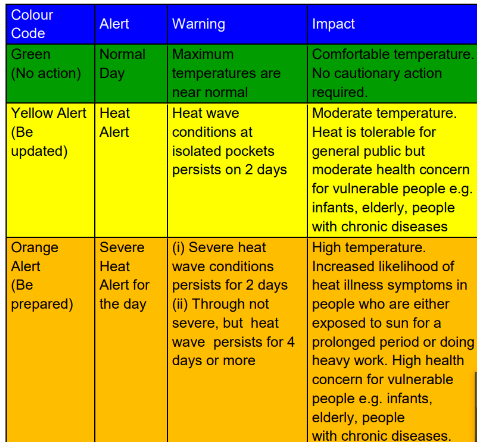Context:
Union Health Minister chaired a high-level meeting to review preparedness of public health services for heatwaves across the country.
- Many people are suffering from the scorching heat across the country.

Image Source: IMD
About Heat Waves:
- Heat waves are defined as prolonged episodes of extreme temperature over any region.
- The IMD considers the following factors when determining a heatwave:
- Temperature Thresholds:
- (a) Plains: A heatwave is declared in the plains when the maximum temperature reaches at least 40 degrees Celsius.
- (b) Coast: Along the coast, a heatwave is declared when the maximum temperature reaches at least 37 degrees Celsius.
- (c) Hilly Regions: In hilly regions, a heatwave is declared when the maximum temperature reaches at least 30 degrees Celsius.
- Temperature Deviations from Normal: Alternatively, a heatwave is declared when the maximum temperature rises by between 4.5 degrees Celsius and 6.4 degrees Celsius above the normal temperature.
- Severe Heatwave: If the maximum temperature departs from the normal by more than 6.4 degrees Celsius, a severe heatwave is declared. This indicates an exceptionally intense and potentially dangerous heat event.
- Extreme Heat: Additionally, a heatwave condition arises when an area records a maximum temperature of more than 45 degrees Celsius and up to 47 degrees Celsius on any given day.
Formation of Heat Waves:
- A heatwave is formed when static high pressure is generated in the upper atmosphere over a region for several days up to several weeks.
- This static high pressure generates a hot mass of air, which is stagnant for many days and weeks, which results in the trapping of more heat that also reduces the convection currents.
- The high-pressure acts as a barrier and forces the mass of air to sink to the surface of the land that preventing heat from rising.
- This hot mass of air accumulates only heat and humidity without any trace of precipitation that causes abnormally high temperatures.
Health Impacts of Heat Waves:
- The health impacts of Heat Waves typically involve dehydration, heat cramps, heat exhaustion and/or heat stroke.
- The signs and symptoms are as follows:
- Heat Cramps: Ederna (swelling) and Syncope (Fainting) generally accompanied by fever below 39°C i.e.,102°F.
- Heat Exhaustion: Fatigue, weakness, dizziness, headache, nausea, vomiting, muscle cramps and sweating.
- Heat Stroke: Body temperatures of 40°C i.e., 104°F or more along with delirium, seizures or coma. This is a potential fatal condition.
Way Forward:
- Establish Early Warning System and Inter-Agency Coordination to alert residents on predicted high and extreme temperatures.
- Identifying heat hot spots through appropriate tracking of meteorological data and promoting timely development and implementation of local Heat Action Plans.
- Further research using sub-district level data to provide separate indices for urban and rural areas to enable more targeted geographical interventions.
- Popularisation of simple design features such as shaded windows, underground water storage tanks and insulating housing materials.
- Increasing green cover could help mitigate heat waves and urban forest should also need to be increased.
News Source: The Indian Express
![]() 21 Jun 2023
21 Jun 2023
